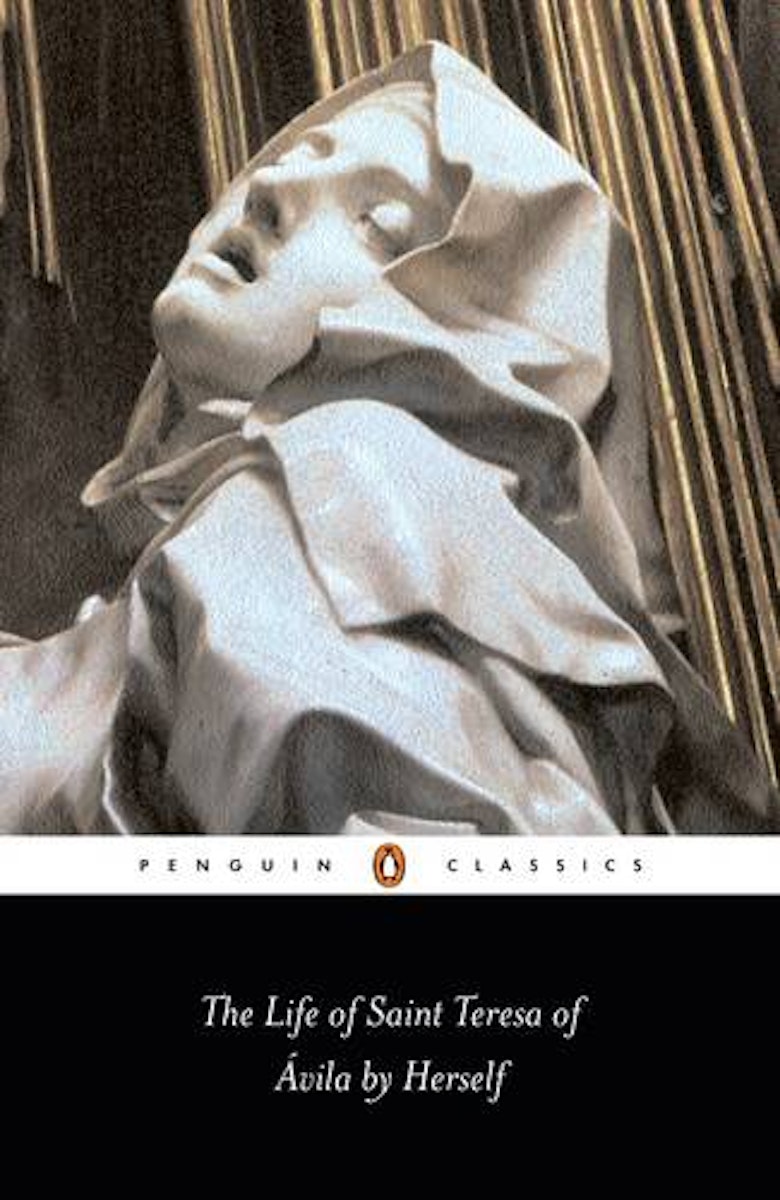
The Reluctant Levitator Teresa of Avila’s Humble Raptures
Levitation was the last thing Teresa of Avila wanted. It drew the wrong kind of attention and embarrassed her in public. She tried to remain grounded, clinging to furniture when the weightlessness set in, and then suddenly, it stopped for good. Carlos Eire reads Teresa's autobiographic Vida and finds the 16th-century saint complaining to God about the aethrobatic miracles that he forced her to endure.
November 8, 2023
-edit.jpg?fit=max&w=1200&h=850) Scroll through the whole page to download all images before printing.
Scroll through the whole page to download all images before printing.After Jusepe de Ribera, Santa Teresa de Ávila (detail), ca. 17th century — Source.
One of the best-known levitators of the early modern age, and one of the most unwilling, is Saint Teresa of Avila. Teresa de Ahumada y Cepeda (1515–1582) became a Carmelite nun in her teens, at the Convent of the Incarnation in her native Ávila, a walled city in Old Castile. During her twenties she was plagued by an illness no doctor could properly diagnose or cure. Brought to death’s door, literally, she was taken for dead and readied for burial but regained consciousness only a few hours before being lowered into her grave. Teresa remained paralyzed afterward for quite some time and eventually recovered, albeit slowly and painfully. A lukewarm nun for many years after returning to her convent — according to her own disparaging estimation — Teresa began to experience visions and raptures in her forties. As these intensified quickly and dramatically, she naturally came under suspicion of being either demonically influenced or a brazen fraud. At the same time, however, many around her were convinced that her experiences were genuinely divine in origin. Consequently, her superiors ordered her to write a detailed account of her life and her ecstasies, under the watchful eye of the Inquisition. That text, which came to be known as her Vida, or “autobiography”, is an attempt to convince everyone that her remarkable experiences are truly supernatural. And an essential part of the narrative is Teresa’s constant emphasis on her own humility and on the pain and embarrassment caused by the ecstasies she experienced in public, or which became public knowledge, especially those ecstasies in which she levitated.
Teresa’s raptures and levitations are unique for several reasons, three of which are most significant. First, no other Christian levitator has provided as full a first-person account or described and analyzed the experience in as much detail as Teresa. Second, no other levitator has complained as often and as loudly about levitating as Teresa. And third, few other levitators have brought about an end to levitations as suddenly and dramatically as Teresa. Obviously, her detailed analysis of her own levitations cannot be taken as empirical “proof ” of the reality of her levitations, but they do provide an exceptionally clear window into her perceptions, or at least into how she wanted others to understand the phenomenon. And as of yet, no other Christian levitator has ever surpassed Teresa on this account.
In her Vida Teresa tends to use the term “arrobamiento”, or rapture, for the experiences that take her into the heavenly realm of the divine. Sometimes, however, she also uses “arrebatamiento”, or ravishment, for such experiences or suggests that arrebatamiento is in fact a kind of arrobamiento, as she does when she says, “While I was reciting a hymn, there came to me an arrebatamiento so sudden that nearly took me out of myself: something I could not doubt, for it was so clear. This was the first time that the Lord had granted me the favor of any kind of arrobamiento.”1 Regardless of the term used, Teresa makes it clear that whether one levitates or not during an arrobamiento, the body is often affected intensely, even violently, primarily through sense deprivation and paralysis and a lapse into a trance-like state accompanied by physical aftereffects that linger for a while. “Let us now return to raptures [arrobamientos], and to their most common traits. I can attest that after a rapture my body often felt so light that it seemed to weigh nothing at all: and sometimes this was so overwhelming that I could hardly tell if my feet were touching the ground. For, during the entire rapture, the body remains as if dead and unable to do anything itself.” And in whichever way it was positioned when seized by the rapture, that is how the body stays: whether standing, or sitting, or with the hands open or clasped.2
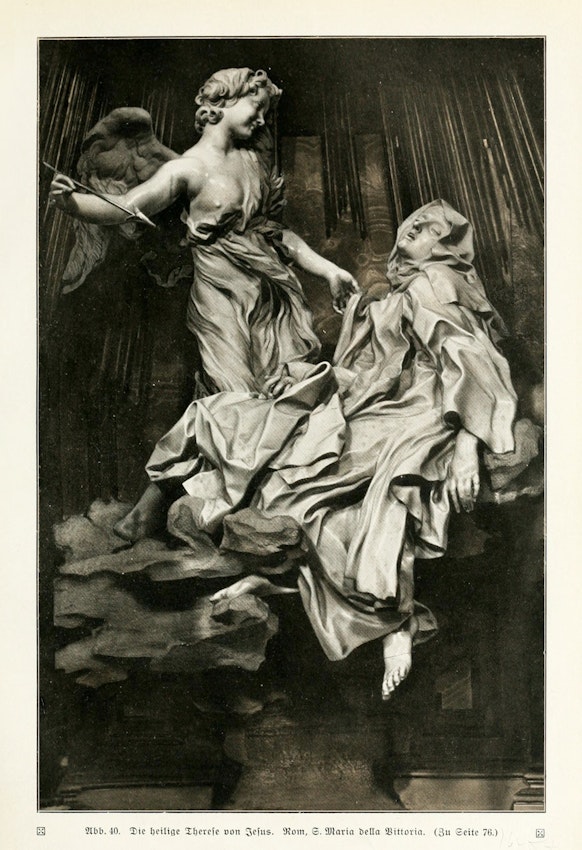 Scroll through the whole page to download all images before printing.
Scroll through the whole page to download all images before printing.Photograph of Gian Lorenzo Bernini’s Ecstasy of Saint Teresa, a mid-17th century sculpture in Rome’s church of Santa Maria della Vittoria. The photograph comes from Max von Boehn, Lorenzo Bernini; seine Zeit, sein Leben, sein Werk (1912) — Source.
This state of suspended animation brings the body close to death and takes quite a toll on it. In one passage, Teresa says that during these raptures one can feel “like someone who is being strangled, with a rope around their neck, still struggling to catch a breath.”3 Again and again, Teresa stresses the physical dimension of her raptures, probably because it was the visibly alarming way her body behaved that drew attention to her mystical experiences. She needed to explain what others were witnessing as something inherently spiritual rather than any of the awful alternatives: demonic fits, mere fakery, mental illness, or a physical malady. Based on her own descriptions of her body’s responses to rapture, others could easily mistake such reactions — which would instantly paralyze her and leave her as rigid and insensate as a marble statue — for mere cataleptic seizures: “The hands get freezing cold and sometimes stretched out stiffly like pieces of wood, and the body stays in whatever position it is when the rapture hits, be it standing or kneeling . . . and it seems as if the soul has forgotten to animate the body.”4
Teresa also claims that all sensory input ceases to function, as if the connection between body and soul is temporarily sundered. At the highest point of rapture, she says, “one will neither see, nor hear, nor perceive”, and this is because the soul is then so “closely united with God” that “none of the soul’s faculties are able to perceive or know what is taking place.”5 Even if the eyes remain open, she adds, “one neither perceives nor notices what one sees.”6 Elsewhere, she also highlights the effects of this near-death experience on the body, not only while the event is unfolding but also afterward: “Occasionally, I come close to losing my pulse altogether, according to those of my sisters who have sometimes found me like this . . . with my ankles disjointed, and my hands so stiff that sometimes I cannot even clasp them together. Until the next day my wrists and my body will continue to hurt, as if my joints had been torn asunder.”7
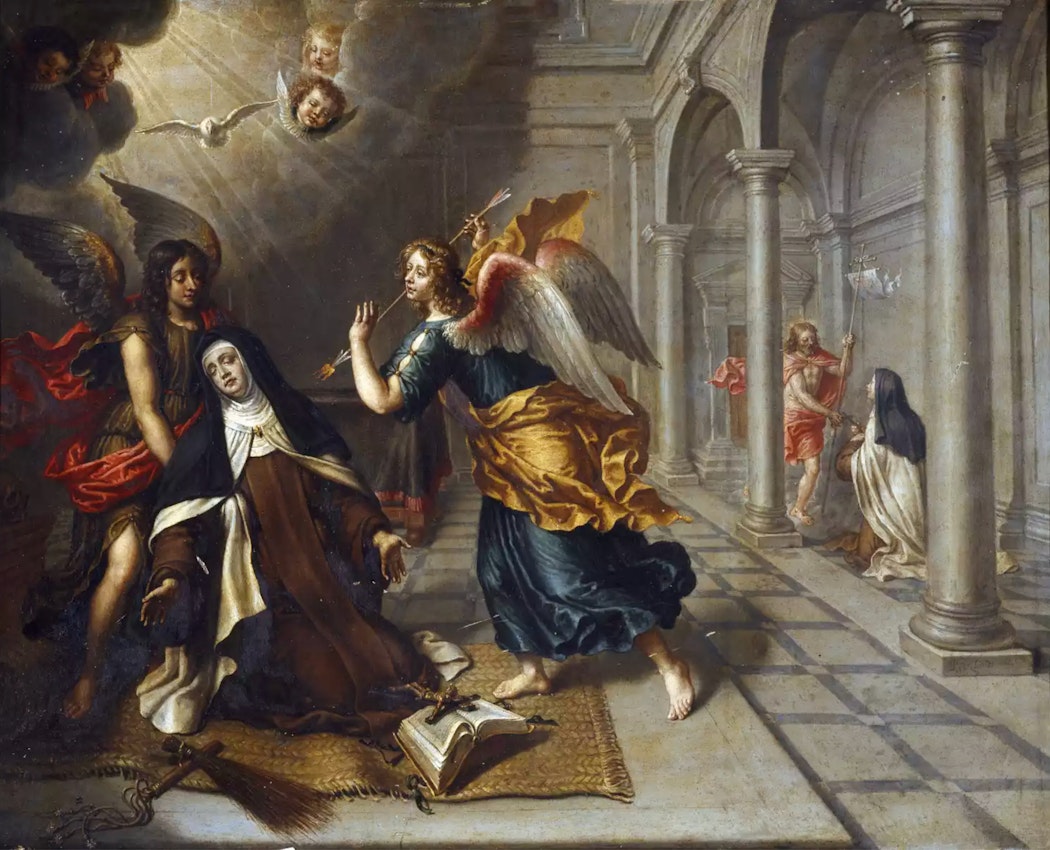 Scroll through the whole page to download all images before printing.
Scroll through the whole page to download all images before printing.Peter van Lint, Saint Teresa of Avila Meets the Angel (17th century) — Source.
Stressing the raw physicality of these experiences alongside their exalted spiritual nature — and again flummoxed by the inadequacy of human language — Teresa also dwells repeatedly on the paradoxical intertwining of pain and bliss, both bodily and spiritual. “These raptures seem like the very threshold of death”, she avers, “but the suffering they cause brings such joy with it that I do not know of anything comparable.” Consequently, she adds, these raptures are “a violent, delectable martyrdom.”8 Elsewhere, Teresa confesses that during those days when her arrobamientos were constant, she went about “as if stupefied” (embovada) and adds: “I did not want to see or speak with anyone, but only to hug my pain, which caused me greater bliss than can be found in the whole of creation.”9
Discerning when Teresa is speaking of the spiritual effects of rapture rather than the physical ones is often difficult, if not impossible. But in some passages she explains that trying to resist arrobamientos takes intense physical effort, further reinforcing her claim that body and soul share in these events with equal intensity and making it abundantly clear that levitations are nearly as impossible to resist as purely spiritual raptures.
I have wanted to resist many, many times, and have put all my strength behind it, especially with raptures in public, and often also with ones in private, when I feared I was being deceived. Sometimes I could resist somewhat, at the edge of exhaustion. Afterwards I would be completely worn out, like someone who has fought against a powerful giant. At other times resisting has been impossible, and my soul has been carried away instead, and quite often my head too, along with it, without being able to stop it, and sometimes my whole body too, which has even been lifted off the ground.10
In other instances, Teresa explicitly refers to levitations, and what she has to say about her inability to resist these “favors”, as well as the physical trauma involved in resisting, is basically identical. “When I tried to resist these raptures”, she says, “it seemed to me that I was being lifted up by a force beneath my feet so powerful that I know nothing to which I can compare it, for it came with a much greater intensity than any other spiritual experience and I felt as if I were being torn to shreds, for it is a mighty struggle, and, when all is said and done, there is no point to it if this is the Lord’s will, for His power can never be overcome by another.”11
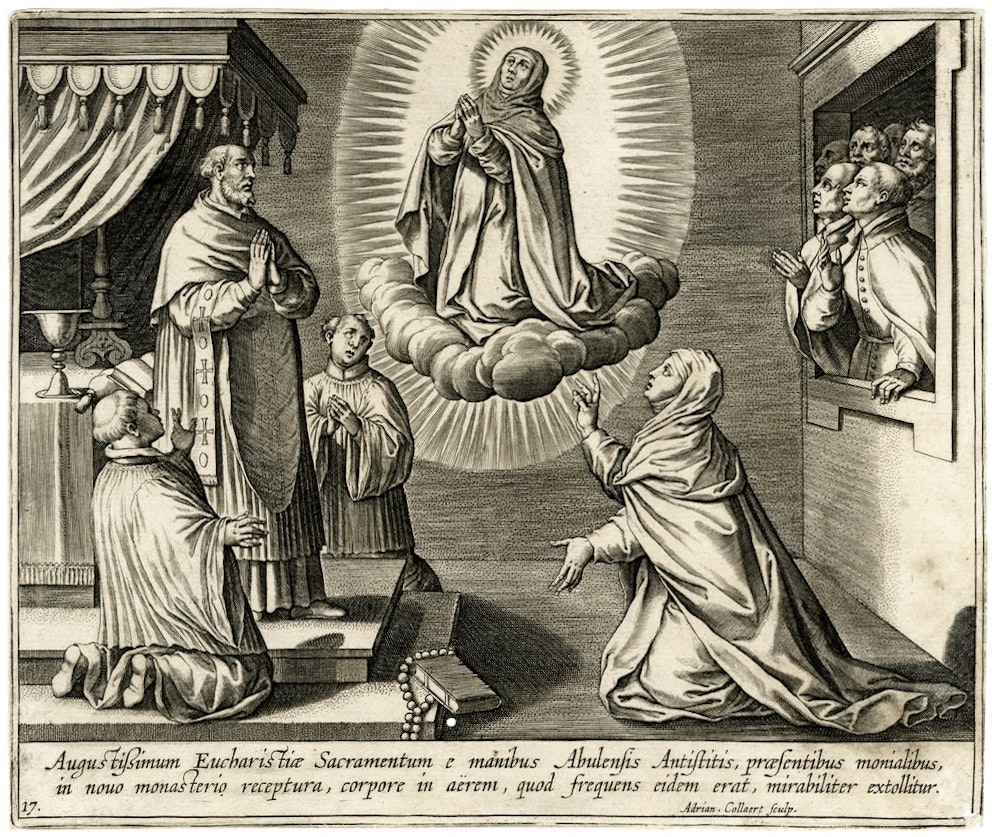 Scroll through the whole page to download all images before printing.
Scroll through the whole page to download all images before printing.Adriaen Collaert’s engraving depicting the miracle of Teresa’s levitation, from a series of prints about the life of Teresa de Avila published in Antwerp ca. 1613 — Source.
Teresa’s stress on the irresistibility of raptures and levitations ultimately needs to be placed in the context of the power relationship between her and her confessors and superiors, as much as in the context of whatever she might have felt or thought about the power relationship between her and God. Urged to resist her raptures when they first began and blamed by her confessors for not preventing them, Teresa needed to highlight this issue of resistance in the autobiographical account she was ordered to write.12 And she also needed to underscore the point that she continually begged God to refrain from showering her with arrobamientos, especially those in which she levitated in the presence of eyewitnesses who would immediately broadcast news of the wondrous miracle they had just seen. As Teresa saw it, the wider that tales of her levitations spread and the more that adulation of her intensified, the worse for her and the church as a whole. Outlining the experiences that can be expected in the penultimate stage of the mystical ascent — the sixth of the seven mansions that she charts in The Interior Castle (1577) — Teresa has this to say: “In this mansion arrobamientos occur continually without any way of avoiding them, even in public, and then the persecutions and murmurings follow, and even though the soul wants to be free from fears, she is never free of them, because so many people foist them on her, especially her confessors.”13
Teresa’s efforts to control her levitations were much more than purely verbal or limited to prayer. According to eyewitnesses, there was a brute physicality to her resistance. Domingo Bañez, a prominent Dominican theologian who served as one of Teresa’s spiritual advisors, said he and many other people once saw Teresa levitate immediately after receiving communion and that she clung to a grille in the church, “greatly distressed”, and begged God, out loud: “Lord, for something that is as unimportant as putting an end to these favors with which you shower me, do not allow a woman as wicked as me to be mistaken for one that is good.” Others, too, would testify that they saw her clinging to the mats on the choir floor and rising up in the air with them in her hands, which she did to signal the other nuns to pull on her habit and bring her back down.14
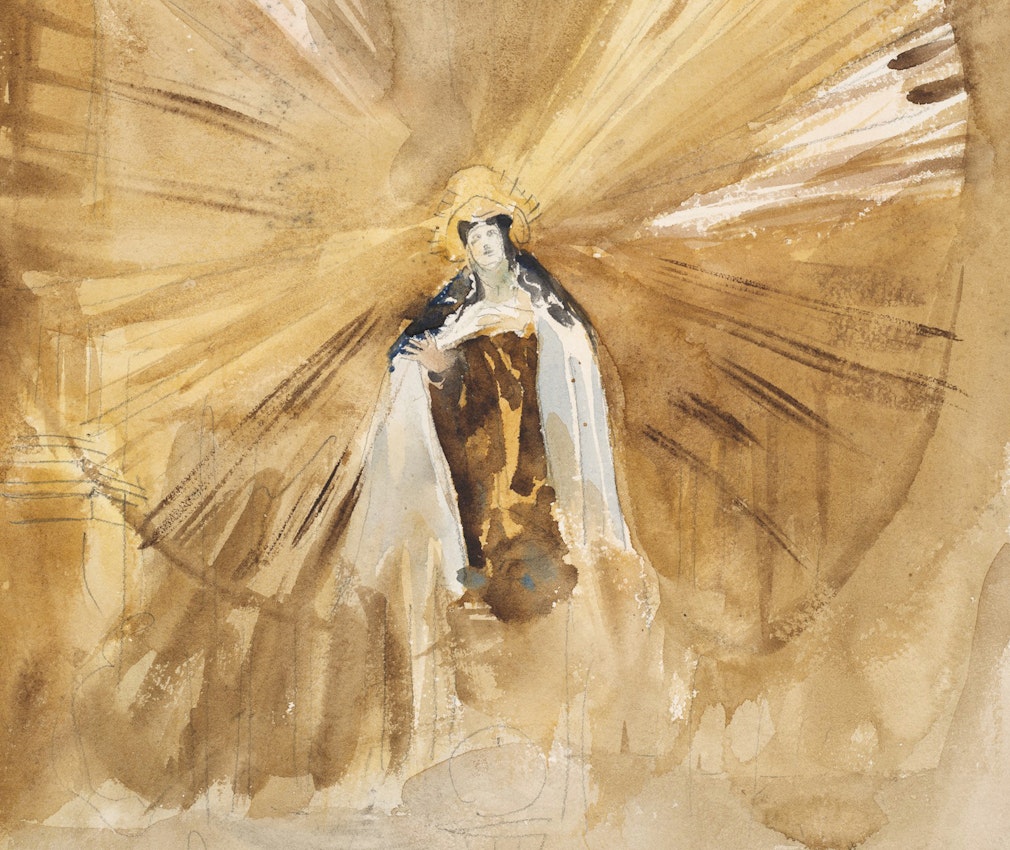 Scroll through the whole page to download all images before printing.
Scroll through the whole page to download all images before printing.John Singer Sargent, Saint Teresa of Avila (detail), ca. 1903 — Source.
When all is said and done, one of the most remarkable aspects of Teresa’s levitations is her attitude toward them and how much she complained about them, not just to those around her but to God Himself. As she says in The Interior Castle, speaking of herself in the third person: “She does nothing but beg everyone to pray for her and beseech His Majesty to lead her by another road, as she is advised to do, since the road she is on is very dangerous.”15 Much like Saint Catherine of Siena, who received stigmata that were invisible, Teresa preferred to receive raptures that were hidden from others’ eyes.16
According to her and to those around her, she suddenly stopped levitating, and her nonlevitating public raptures became much less frequent. Although she mentions this in the Vida and says that it happened when she was writing the final version of the twentieth chapter, she does not dwell on the subject. In fact, this information is easy to miss, tucked away as it is in a long rambling narrative, somewhat cautiously, almost as an aside.17 Chances are that Teresa did not want to press her luck, for she would not want her superiors and confessors to think that she was boasting in any way or that she was underestimating God’s omnipotence and His absolute control of her ecstasies. “I often begged the Lord not to grant me any more favors with visible external signs”, she explains, “for I was weary of having to contend with such worries and, after all, His Majesty could grant me such favors without anyone knowing it. Apparently, He, in His kindness, was inclined to hear my pleas, for up until now — even though in truth it has only been a short while — I have never again received any such favors.”18
Yet no matter how much Saint Teresa sought to distance herself from levitation, belief in this phenomenon would only intensify among Catholics after her death, thanks in no small measure to her fame. During the seventeenth century, the beginning of the so-called Age of Reason, levitators kept popping up throughout the Catholic world, not just in Europe but also in those places where Spain, Portugal, and France had colonies. And quite a few of them walked the earth — or hovered over it — at the same time as Isaac Newton was using empiricism and inductive reasoning to come up with his law of universal gravitation. Many of these baroque aethrobats followed the paradigms established by the likes of Saint Teresa. Others, however, flew higher and more spectacularly than ever before.19
Carlos M. N. Eire is the T. L. Riggs Professor of History and Religious Studies at Yale University. He is the author of They Flew: A History of the Impossible, Waiting for Snow in Havana, winner of the National Book Award, and of War Against the Idols; A Very Brief History of Eternity; and Reformations. He lives in Guilford, CT.
Excerpted and adapted from They Flew: A History of the Impossible by Carlos Eire, new from Yale University Press. Copyright © 2023 by Carlos Eire. Reprinted by permission. All rights reserved.

